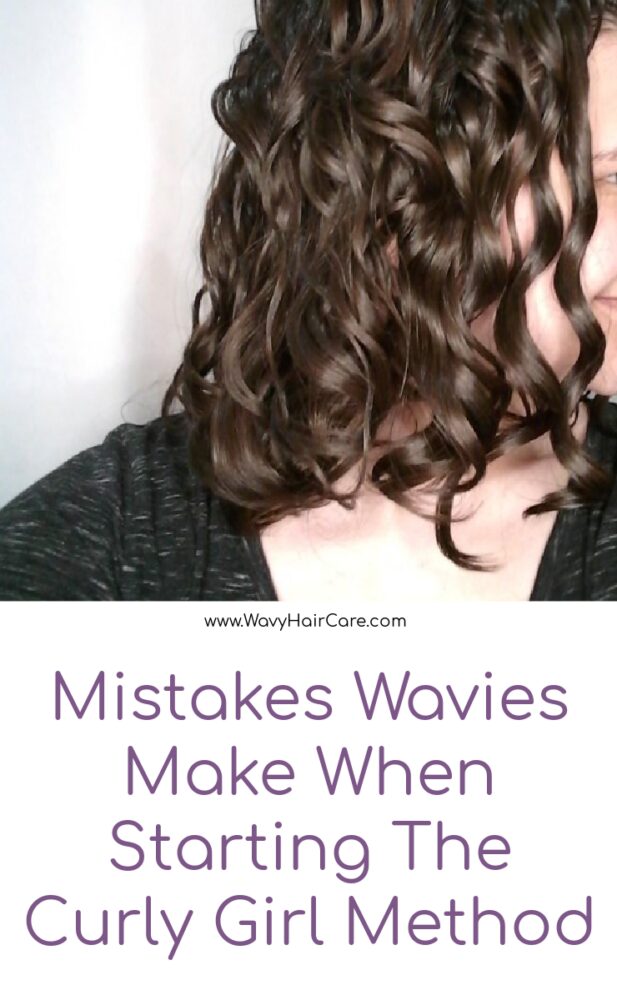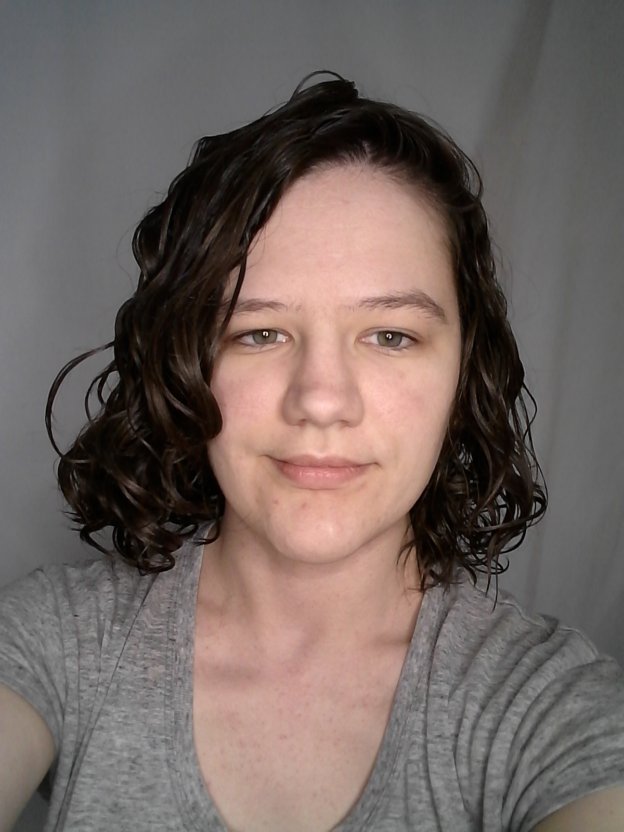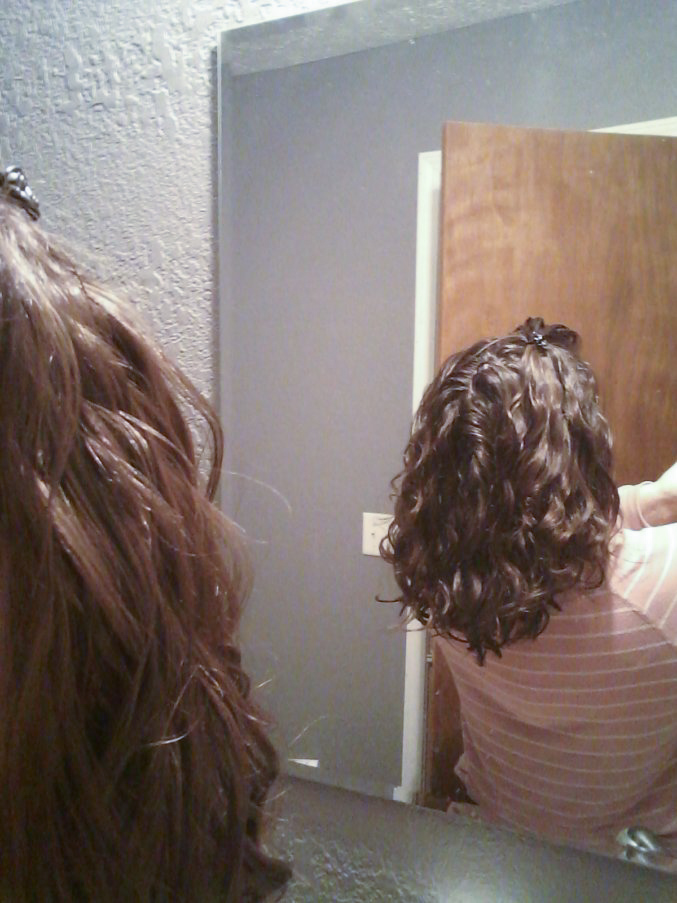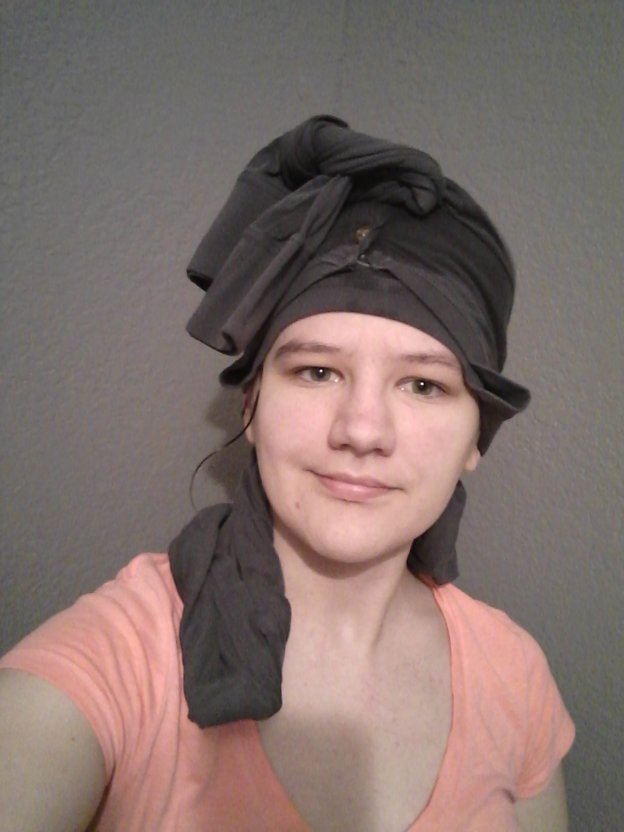For some people with wavy hair, we don’t even realize our hair is wavy until we’re adults. I realized mine was wavy a few years ago. For others, they know their hair is wavy but decide to start the curly girl method (or wavy girl method, or modified curly girl method, etc) to try to really take good care of their hair and/or get the results they prefer.
Regardless of why you’re new, there are a few common mistakes that I see people with wavy hair make when starting the curly girl method, or starting to embrace their natural hair texture. I thought I’d cover some of the more common ones, so that anyone who finds this early on in their journey can get help!

Common curly girl method mistakes for wavy hair
1. Fixating on your curl pattern.
I totally get being excited by, or confused by, or curious about, your curl pattern. I definitely have been all of the above! And I have a wavy hair curl pattern chart to try to help you determine your curl type, if you still aren’t sure. However, it’s common for newbies to think that your curl pattern is the biggest factor in how to care for your hair. That’s not true.
There are common differences between wavy and curly hair those factors can contribute to how we care for our hair. It’s not the curl pattern itself that matters though. So, if you are 2b, don’t assume that what works for someone else with 2B waves will work for you. I did that, and it didn’t work well for me!
2. Using Heavy Products
Most curly girl method content is created by people with curly hair, which tends to be more dry than wavy hair. This means curly (and especially coily) hair can tolerate (and often needs) a lot more moisture and oils in their routine than people with wavy hair tend to need. Someone with curly hair may recommend running out and buying shea-butter heavy products to start with.
Or, they start a routine that has multiple moisturizing leave-in products. For most wavies, this will leave your hair weighed down and potentially even oily/greasy. Generally speaking, wavies need light products. My post how to tell if your wavy hair is weighed down may help if you’re uncertain if your products are too heavy.

3. Exclusively cowashing
People with curly and coily hair sometimes really benefit from cowashing rather than using shampoo. Some people with wavy hair enjoy cowashing, too. It’s far less common for people with wavy hair to feel like they get good results from cowashing, though. Many wavies who do cowash, only do so sometimes, not all the time.
Many who are new hear that cowashing is superior to using a sulfate-free shampoo/low poo, so they try to exclusively cowash. My advice is to listen to your hair. If your scalp itches, has build-up, looks flat/greasy, or just doesn’t feel good when cowashing? Switch to a curly girl-approved shampoo. If your hair looks and feels great while cowashing then by all means, continue.

4. Using oil or creams instead of gel or mousse.
In other words, trying to use oils or creams to get definition or frizz control. This seems particularly common among those who previously thought their hair was straight. If you aren’t used to using hair products outside of shampoo and conditioner, the idea of using gel or mousse can be overwhelming or sound offputting.
I get it, which is why I have a blog post on Does wavy hair really NEED gel? because I tried to avoid gel, too. It sounded yucky, I thought it would feel bad and may even look bad!
However, many people with wavy hair really need a product with good hold to get defined waves that hold their shape over the course of a day, or even multiple days. Using oils, leave-in conditioners or creams won’t usually give you good definition, help very much with frizz (at least not after it dries) or help your style last very long.
Gel or mousse are way more likely to provide adequate hold. Some custards, jellies, gelee’s, etc can too. I tested out using hairspray to hold wavy hair and that worked! Generally, oils don’t offer any hold, and creams very rarely do.
5. Focusing too much on product, not enough on routine.
Some people start the curly girl method, try one wash with a set of products, don’t like the results, and go buy a whole new product line. Some seem to think that the answer to getting the style they want is all about finding the right product. Products do matter.
For me what matters most in products in how heavy vs light they are, how much hold my styler provides, and protein level. There are definitely times where changing products is the best way to solve a problem.
However, many seem to think that there is a product that should be purchased for any issue they have. In my experience, technique matters WAY more than products. In fact, technique can be quite finicky.
I have sometimes felt like my hair has changed and I can’t figure out why, and then eventually realize I have gotten slightly lazy and made some tiny difference in my technique that is making a visible difference in my results.
Things like how long I scrunch for, whether I lean over or am fully upside down while diffusing, whether I glaze products in or just scrunch them in, endless little details can make a big difference in results.
I ran an experiment on my hair to compare using the ‘wrong’ products but the ‘right’ techniques, and then using the ‘right’ products but the ‘wrong’ techniques, to see which gave better results.
I predicted that the ‘bad techniques’ version would be worse, and it was. I was still surprised at how much of a difference it made! See my post does product or technique matter more post to see that experiment.

6. Making several new changes at once
To figure out which techniques and products work well for you, you have to see the specific impact of each technique or product individually. Often newbies get excited about all the possibilities and will try out 2 new techniques and a new product on the same wash day.
Or they might look up 3 people’s wavy hair routines and just keep trying full routines from others, making tons of changes each time instead of creating their own.
The potential problem with making many new changes at once is you won’t know what really caused any changes you see. I suppose if the results were just perfect, you’d know to keep those techniques and that product.
However, if you have results you’re unhappy with, or sort of mixed results – like maybe you got better definition but worse frizz. How would you know what caused the increase in frizz, and what caused the improvement in your definition, if you made multiple changes at once? You really wouldn’t.
I still try several new things at once on occasion just for fun but when I do, I am prepared to be totally confused at my results, whether good or bad. So most of the time I try to just make one change at a time, so that I can really learn what the impact of that technique or product is. I feel this is particularly important when you’re new and really just learning your hair.
7. Not clarifying.
The official curly girl method says to do a reset wash (clarifying wash) before starting the curly girl method, and then never using a sulfate ever again. The theory, as I understand it, is that if you don’t use silicones, you shouldn’t ever get build-up so you shouldn’t need to clarify.
Most people who follow the curly girl method feel like they do need to clarify even if they don’t use silicones as they can get build-up from other product ingredients, from minerals in their water, from the environment, etc.
People with wavy hair, in particular, seem to feel like they need to clarify more often than those with curly hair. How often you should clarify is definitely something you’ll have to learn based on experience with your own hair. I have a blog post about clarifying wavy hair if you want to know more.
However, some people jump in and go months without clarifying and their hair often suffers for it. Build-up can just feel bad, but it can also weigh your hair down, make your hair frizzy, limp and so on. I have a post on how to fix limp wavy hair if that’s a struggle you’re having.
I’d recommend that you clarify at least once a month as a starting point, but then try different intervals (maybe try clarifying after two weeks) to see if your get better results clarifying more often.

8. Plopping too long.
“I’m trying to do the curly girl method but my hair is a huge mess in the back!” is a common newbie problem. I have a full blog post on how I style my wavy hair upside down without getting a mess in the back. I’d say plopping too long is one of the more common causes, though.
Particularly for newbies these days, as many learn about the curly girl method from the TikTok that recommends plopping. If you quickly google plopping, it often recommends 30 or 45 minutes, etc. That may work for some, but for many wavies it’s too long.
9. Going to bed with wet hair.
Often when people say they can’t get a hair cast, or their curls never clump, or their hair is always messy in the back – they’re going to bed before their hair is dried. If you’re used to showering at night, I get why you may try to go to bed with wet hair.
It just doesn’t work if you’re using gel or mousse, though. You need that cast to form and dry before you sleep on your hair. For me, diffusing is a must because air-drying just takes far too long for my hair type. Not familiar with what a cast is? Check out my blog post what is a gel cast & how to create one.
10. Scrunching while it dries.
Scrunching or microplopping (click for my micropop tutorial) are common wavy hair techniques. Some newbies think it will produce better results if they scrunch their hair or microplop their hair for a long time until it’s dry.
In many cases, this will result in your clumps breaking up and getting frizzy. It can also prevent a cast from forming. If your waves require support from product, not getting a cast can cause your waves to fall flat lot faster.
Basically any form of touching your hair too much as it’s trying to dry can disrupt your waves from forming well and lasting.
11. Focusing on “the rules” over your personal experience
“Well, I have been using X-shampoo and Y-conditioner, but I saw someone else say these are bad. Now I don’t know what else to try?” is a type of comment I see in forums and groups sometimes.
There are a lot of strong beliefs out there regarding wavy hair care. Some are really strong advocates for really strict curly girl method rules. Some people believe strongly that certain ingredients are bad, certain brands are bad, certain techniques are bad, some say that drugstore products are low quality, some believe preservatives are bad, some prefer vegan products, etc.
We’re all entitled to our opinions, of course…but I find it important to remember that other people’s opinions are often just opinions. If your opinion is different from someone else’s, that doesn’t mean that either of you are wrong.
I mean, I have this whole blog about wavy hair and while I am no expert, I am kind of obsessed with reading about wavy hair. I have a good grasp on a lot of things, which is why I share them here, to help newbies. I still recognize that hair types vary a ton, and then people have different preferences as well.
This means that different things work for different people. While there are some facts and science involved with haircare, a majority of what is discussed in wavy and curly hair communities is opinion based or preference-based. So, if someone else disagrees with what you’re doing or what you like, I’d try not to sweat it too much.
My philosophy is to try to learn your hair and what works for you.
Feel free to drop a comment sharing what mistakes you made early on! I made lots of these, myself.
Thanks so much for your info!! I realized I have wavy hair and have been wanting to learn how to take care of it and enhance my waves. Your tips and tricks are so so helpful!
I just love your attitude of being curious and experimenting to find what works for you, instead of trying to trap newbies with strict rules. Thanks for the encouragement and so much awesome information as I’m starting my wavy journey!